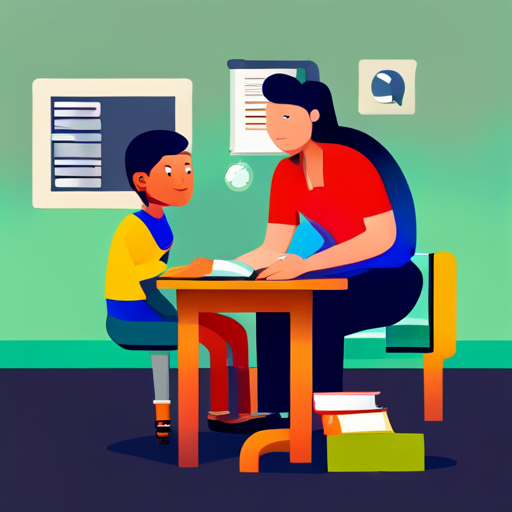Are you an ESL teacher looking for ways to improve your students’ reading fluency? Reading fluency is an essential skill for ESL students to master as it not only helps them comprehend text more easily but also enables them to communicate more effectively in English. Fortunately, there are many drills and techniques that you can use to enhance your students’ reading fluency.
In this article, we will explore the importance of reading fluency for ESL students and provide you with effective drills and techniques to improve their reading skills. Additionally, we will offer you practical tips that you can use in the classroom to help your students become more fluent readers.
Whether you are a seasoned ESL teacher or a new educator, this article will provide you with valuable insights and strategies to help your students become more confident readers.
Table of Contents
Understanding the Importance of Reading Fluency for ESL Students

It’s crucial for non-native English speakers to be able to read smoothly and effortlessly, as this skill greatly impacts their language proficiency. Reading fluency is the ability to read accurately, quickly, and with expression. This skill enables ESL students to comprehend and process information faster, which is essential for their academic and professional success.
Reading fluency also helps ESL students to improve their grammar, vocabulary, and pronunciation. As they read more fluently, they can recognize and internalize grammatical structures and new words more easily. Moreover, they can practice the correct pronunciation and intonation of words and sentences, which is critical for effective communication.
In addition, reading fluency can boost ESL students’ confidence and motivation. When they read fluently, they feel more comfortable and competent in using the language. They are also more likely to enjoy reading and learning, which can lead to a lifelong passion for reading and self-improvement.
Therefore, enhancing reading fluency should be a top priority for ESL students and their teachers.
Effective Drills to Improve Reading Fluency

You may have heard of different effective drills to improve your reading fluency. Some of these drills include Repeated Reading, Timed Reading, Choral Reading, and Partner Reading. Each of these drills involves different techniques that can help you become a better reader.
By practicing these drills, you can increase your reading speed, accuracy, and comprehension. These essential skills are particularly important for ESL students.
So, if you want to improve your reading fluency, consider trying out some of these drills. They can help you become a more confident and skilled reader.
Repeated Reading
By practicing reading the same passage multiple times, you’ll not only improve your comprehension but also gain confidence in your ability to read smoothly and expressively.
Repeated reading is a drill that involves reading a short passage multiple times until you can read it fluently without stumbling or hesitating. The goal of this drill is to help you memorize and internalize the text so that you can read it with ease and confidence.
To do this drill, you need to choose a passage that is at your reading level and that you find interesting. Read the passage aloud at a slow pace, paying attention to each word and phrase.
Then, read the passage again, but this time try to read it a little faster and with more expression. Repeat this process several times until you can read the passage smoothly and confidently.
This drill can be done alone or with a partner, and it can be done with different passages to challenge yourself and build your reading fluency.
Timed Reading
Improving your reading speed and confidence is crucial, and timed reading is a highly effective technique that can help you achieve this goal.
Timed reading is a simple, yet powerful exercise that involves setting a timer and reading a passage for a set amount of time. This technique helps you develop your reading fluency by increasing your reading speed and comprehension.
When practicing timed reading, it’s important to choose passages that are at your reading level, so you can focus on increasing your speed and comprehension without struggling with difficult vocabulary or sentence structures.
Start by setting a timer for one minute and reading the passage aloud. After a minute, stop reading and record how many words you read. Repeat this exercise several times, gradually increasing the time by 30 seconds or a minute each time.
Timed reading can be done alone or with a partner, and it’s a great way to track your progress and see how much you’re improving over time.
Choral Reading
Choral reading is a fun and engaging technique that involves a group of people reading a passage aloud together, creating a harmonious and rhythmic flow of words. This method is a great way to enhance reading fluency for ESL students as it helps them work on their pronunciation and intonation while also building their confidence in speaking English.
During choral reading, students can follow along with a native speaker or a teacher, repeating the words and phrases together. This allows them to practice new vocabulary and sentence structures in a supportive environment, where they can get immediate feedback and correction from their peers.
Choral reading also promotes teamwork and collaboration. Students learn to listen and respond to each other, and work together towards a common goal of reading the passage fluently and accurately.
Overall, choral reading is an excellent drill for improving reading fluency and oral communication skills among ESL students.
Partner Reading
Now that you’ve practiced reading aloud with a group, it’s time to try partner reading.
In this activity, you and a partner take turns reading aloud to each other. This can help improve your fluency and comprehension, as you’re able to hear how the words and sentences should sound when spoken correctly.
To start, choose a book or article that’s at your reading level. Sit facing your partner and take turns reading a page or two at a time.
As you read, try to use expression and intonation to make the text sound more interesting. If you come across a word you don’t know, ask your partner for help or look it up together. This will not only improve your vocabulary but also your understanding of the text as a whole.
Partner reading is a great way to practice reading fluency in a supportive and interactive environment. By taking turns and working together, you can improve your pronunciation, comprehension, and overall confidence in your reading skills.
Give it a try with a friend or classmate and see how much progress you can make together!
Techniques to Encourage Reading Fluency

You can boost your reading skills by trying out some fun and effective techniques that’ll help you read more smoothly and confidently.
One technique is to practice sight words. Sight words are common words that you should know how to read without sounding them out. You can find lists of sight words online or ask your teacher for some to practice. Once you’ve mastered a few sight words, try reading short sentences that contain those words. This’ll help you read faster and more smoothly.
Another technique to encourage reading fluency is to read aloud. Reading aloud helps you practice reading with expression and pacing. You can read to yourself or to a friend or family member. If you’re reading to someone else, ask them to give you feedback on how you sound. You can also try recording yourself and listening back to hear how you sound. This’ll help you identify areas where you can improve.
Finally, try using a timer to track your reading progress. Set a timer for a certain amount of time, say 5 or 10 minutes, and read as much as you can in that time. Then, track how many words you read in that time. Each time you practice, try to beat your previous record. This’ll help you build your reading speed and fluency over time.
With practice, you’ll become a more confident and fluent reader.
Practical Tips for ESL Teachers

The section provides useful tips for instructors of English as a second language to assist their pupils in refining their speaking and comprehension abilities.
The first tip is to incorporate reading aloud exercises in the classroom. This can help students practice proper pronunciation, intonation, and pacing. It also allows them to hear the language spoken by a fluent speaker, which is crucial for ESL learners.
Another practical tip is to utilize repeated reading drills. This involves having students read the same passage multiple times until they achieve fluency. It can be helpful to choose a text that’s slightly above their reading level, as this can challenge them to improve their skills. Additionally, teachers can provide feedback and encouragement to help students overcome any difficulties they may encounter.
Lastly, it’s essential to create a positive and supportive classroom environment. ESL learners may feel self-conscious or embarrassed about their language abilities, so it’s crucial to foster a safe space where they feel comfortable practicing and making mistakes. Teachers can achieve this by providing opportunities for students to work in pairs or small groups, using positive reinforcement, and celebrating their progress.
By implementing these practical tips, ESL teachers can help their students enhance their reading fluency and develop their language skills.
Frequently Asked Questions
What is the difference between reading fluency and reading comprehension?
When it comes to reading, two important concepts to understand are reading fluency and reading comprehension.
Reading fluency refers to the ability to read text accurately, quickly, and with expression. Essentially, it’s the ability to read smoothly and easily.
On the other hand, reading comprehension refers to the ability to understand and make meaning from what is being read. It’s the ability to not only read the words, but also to understand what they mean and how they relate to each other.
While reading fluency and reading comprehension are related, they are not the same thing. Fluency is a necessary foundation for comprehension, but it is not sufficient on its own.
To truly understand what you’re reading, you need both fluency and comprehension skills.
How can reading fluency impact an ESL student’s overall language proficiency?
If you’re an ESL student, working on improving your reading fluency can have a big impact on your overall language proficiency.
When you’re able to read more quickly and smoothly, you’ll be better able to understand the meaning of the words you’re reading, which can help improve your reading comprehension.
Additionally, as you become more comfortable with reading in English, you’ll likely find that your speaking and writing skills improve as well.
So, while it may take some practice and effort to improve your reading fluency, the benefits to your language skills can be well worth it.
Are there any specific drills or techniques that work best for younger ESL students?
Are you looking for ways to help your young ESL students improve their reading fluency?
There are several effective drills and techniques that you can use in your classroom. One popular method is to use repeated reading, where students read a short passage several times in order to improve speed and accuracy.
Another technique is to use timed reading exercises, where students read as many words as possible in a set amount of time. Additionally, choral reading, partner reading, and readers’ theater can all be effective ways to improve fluency while also making reading more fun and engaging for students.
By incorporating these drills and techniques into your lessons, you can help your ESL students become more confident and proficient readers.
How can ESL teachers address the individual needs of each student when it comes to reading fluency?
As an ESL teacher, it’s important to remember that every student has their own unique needs when it comes to reading fluency.
One approach to addressing these individual needs is to conduct regular assessments to identify areas where each student may be struggling.
From there, you can tailor your teaching methods to better support each student’s specific needs, whether it’s through one-on-one instruction, group work, or targeted exercises.
By taking the time to understand each student’s strengths and weaknesses, you can help them build the skills they need to become confident, fluent readers.
Are there any common misconceptions about reading fluency for ESL students that should be addressed?
When it comes to reading fluency for ESL students, there are a few common misconceptions that should be addressed.
One of these is the belief that fluency is solely about speed. While speed is important, fluency also involves accuracy, expression, and comprehension.
Another misconception is that fluency can only be developed by reading aloud. While oral reading can certainly help, there are other effective strategies such as repeated reading, partner reading, and choral reading.
By understanding these misconceptions, you can better support your ESL students in developing their reading fluency.
Conclusion
So, there you have it! By now, you should have a solid understanding of the importance of reading fluency for ESL students and some effective drills to help enhance their reading skills.
Remember, reading fluency is a crucial component of language acquisition, and as an ESL teacher, it’s your responsibility to make sure your students are equipped with the skills they need to succeed.
Incorporate these techniques into your lessons, and don’t be afraid to get creative! With patience, practice, and the right strategies, your ESL students will undoubtedly start to see improvements in their reading fluency.
Good luck!
